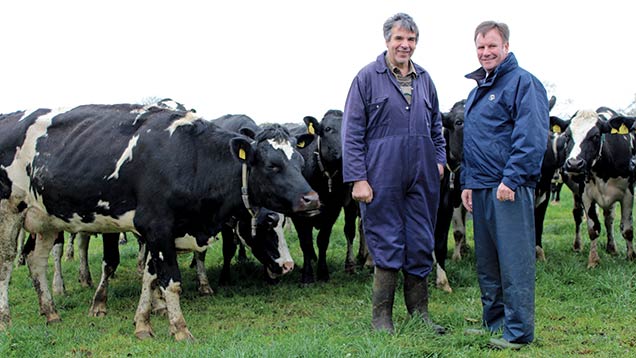Hitting milk cheque bonuses earns dairy famer an extra £150,000
 Keith Hughes and Mole Valley Feed Solution's David Balls.
Keith Hughes and Mole Valley Feed Solution's David Balls. Hitting milk bonus targets and maximising forage use could make the difference between profit and loss for those producers faced with low milk price.
Keith Hughes will add an extra £150,000 to his bottom line this year by getting the most from his milk contract by hitting bonuses for yield.
Base milk price may have dropped on his Arla contract, but ensuring his 600-cow herd is rationed to meet all bonuses available to him means he is protected from the full effects.
Producing extra litres at bonus levels for butterfat and protein is adding 1.91p/litre to his milk cheque. In addition, bonuses for producing milk with low SCC and bactoscans is worth another 0.84p/litre (see box).
“That extra money stabilises the price I receive overall, even if the base price is lower. In October I was still at 31.98p/litre because of bonuses,” says Mr Hughes, who runs Clares Barn Farm, Twycross, Atherstone in Warwickshire, with his wife Denise.
See also: 10 marginal gains dairy farmers can make
Mr Hughes runs a low-input, low-output system, but with many farmers facing a cost of production of more than 30p/litre, the extra bonuses potentially available could mean the difference between profit and loss.
Specific contracts
Regardless of system, the key is to identify how to make the most of bonuses on specific milk contracts, says nutritionist David Balls from Mole Valley Feed Solutions.
“Mr Hughes and I have worked together to get the most from his constituents-based contract. The aim is to get as much milk from forage while maximising constituents and yields,” he explains.
Clares Barn Farm – Milk bonus benefits for October
Tweaking the ration to hit milk contract targets is worth:
- An extra 1p/litre by maximising milk volume.
- An extra 4p/litre by hitting target butterfats.
- An extra 51p/litre for extra protein.
- 84p/litre more by keeping SCC below 250,000 cells/ml and bactoscans below 50
Total potential yearly benefit = 3.75p/litre x 4m litres = £150,000
Mr Hughes’ autumn-block calving herd are a three-way cross between Friesian, Swedish Red and a Kiwi-cross.
The herd averages 6,500 litres, with 3,600 litres from forage, at 4.33% butterfat and 3.4% protein.
In November, cows were out either day or night and receiving a TMR of maize, grass and lucerne silage, molasses and 7kg of blend.
With bonuses in mind plus the potential to reduce wastage, the farm has started feeding a 23.5% quality protein blend, instead of mixing straights on farm.
Protein blend
“The blend is balanced for starch, NDF and protein with the aim to reduce total diet crude protein, maximise the protein produced in the rumen and meet metabolisable protein requirements.
“It is this unique nutrient combination that helps to drive milk fat and protein,” says Mr Balls.
The high nutrient density of the concentrate means there is more room for cows to eat forage and hit total dry matter intake targets of 20kg/day in early lactation.
“We have fed a little more blend to increase peak yields by about 2 litres a cow, all while maintaining fertility and cow condition,” explains Mr Balls.
“This also means we can hold yields longer and produce more milk when cows are turned out in the spring, when it is cheaper to produce.”
It costs 16.5p to produce an extra litre of milk at a feed rate of 0.75kg. At a milk price of 30p/litre, that’s worth 13.5p/litre to Mr Hughes.
The transition cow diet has also been tweaked to include a higher-protein concentrate along with forages. This conditions the rumen to help get cows up to peak yield after calving.
Forages
Forages play a vital role in keeping costs down and hitting bonuses. Mr Hughes says the aim is to produce a balance of energy and protein across a number of forages to reduce bought-in feed costs.
“Lucerne is high in protein at about 17%, has good scratch factor to help butterfats and also drives milk generally. We also have Italian ryegrass and red clover leys, which we clamp with perennial ryegrass and white clover to produce a 17% protein silage,” he explains. Maize starch also drives milk proteins.
Grazing
Grazing management is also crucial to maximise intakes. The herd is rotationally grazed on 2ha paddocks with grass monitored weekly with a plate meter. Cows enter paddocks at 2,800-3,000kg DM/ha and graze down to 1,500kgDM/ha.
Mr Balls says the approach at Clares Barn Farm is a good example of the role of marginal gains when milk price is poor. “It’s the small tweaks that can make all the difference and on Mr Hughes’ system, that’s getting the most from his milk contract and home-produced forages.”
